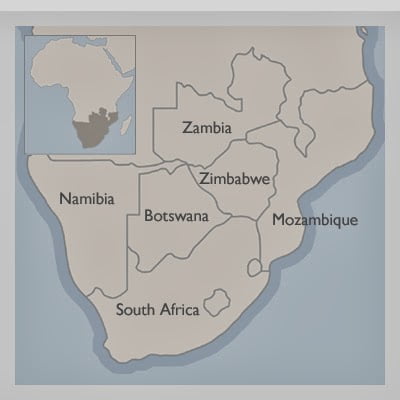WEATHER AND GAME VIEWING SEASONS IN BOTSWANA
Thanks to New Frontiers Tours for this great information on seasonality in Botswana. For in-depth questions on regions, seasonality, game viewing and lodges please ask your New Frontiers tour consultant or Sally Moon, Southern Africa product director at New Frontiers.
Botswana’s climate is semi-arid. Though it is hot and dry for much of the year, there is a rainy season, which runs through the summer months. Rainfall tends to be erratic, unpredictable and highly regional. Often a heavy downpour may occur in one area while 10 or 15 kilometres away there is no rain at all. Showers are often followed by strong sunshine so that a good deal of the rainfall does not penetrate the ground but is lost to evaporation and transpiration.
As a result of global warming weather patterns around the world are changing and Botswana is no exception. The following information on climate and what to expect from the bush is purely a guideline.
September – October is spring. The climate is changing and winter is all but gone. With the oncoming threat of rain the air becomes hot and October day time temperatures head into the high 30’s °C with night time temperatures averaging the low 20’s °C.
November – March is summer or ‘Green Season’. Temperatures may be very high however summer is also the rainy season, and cloud coverage and rain can cool things down considerably, although only usually for a short period of time. January and February are generally the wettest months with spectacular afternoon thunderstorms and dramatic skies.
April – May is autumn. There is little rainfall and although the days are still warm the nights are distinctly cooler. This is a lovely time of year.
June – August is winter. Clear cobalt blue skies and bone-dry, the air is seductively warm during the daylight hours but, because there is no cloud cover, cold at night and in the early mornings. Sometimes bitterly so – frost is common and small quantities of water can freeze.
Contrary to popular belief Botswana is a year-round wildlife destination however when it comes to game viewing, birding, botany and photography some months are more productive than others. When to visit really depends on what you want to see and do.
The best months to visit Botswana are from April through to October – in terms of both weather and game viewing.
In April/May the floodwaters from the wet Angolan highlands arrive at Mohembo at the top of the Okavango Delta panhandle. Making slow deliberate progress through the vast wetland system that is the Okavango Delta the flood reaches the inner delta by June and peaks in July or August. Water seeps into areas where there was none the day before creating new channels and waterways waiting to be explored on mokoro and boat excursions.
June is an exciting month as this is when wild dogs begin to search for dens. The Kwando and Kwara concession areas offer some of the best wild dog viewing in Africa. Exciting hunts and playful puppies – what more could you wish for?
As winter takes its grip and seasonal pans begin to dry huge herds of elephant and buffalo congregate around permanent water sources closely followed by silently waiting predators. In September the skies are alive with colour as thousands of carmine bee- eaters return from their winter feeding grounds and start nesting on the banks of the Kwando River. Water levels slowly start to drop as the waters from Angola have completed their trek. Although incredibly hot game viewing goes from strength to strength and is further enhance by the lack of foliage as bushes and trees shed their leaves and grasses have been eaten thus providing fantastic visibility. There is always some water in the Okavango Delta, but by the end of October the channels are narrow and the floodplains are mossy green but dry. The Gadikwe heronry near Kwara is full of activity with hundreds of birds breeding and nesting.
When the summer rains start towards the end of November Savute comes alive. Its rich new grasses are a magnet for herds of Burchell’s zebra and wildebeest which can be found on the Savute Marsh where they foal before making for the lush grazing grounds of the Mababe Depression further south.
Towards the end of November the rain arrives and this in turn brings about many changes in the ecological systems. Along with the first rains comes the rejuvenation of the vegetation, with new emerald green foliage and an abundance of flowers. In the animal kingdom it’s a time of new beginnings as the birthing season begins with the tsessebe, followed by impala, lechwe and wildebeest. Predators seek out the vulnerable young and kill many times a day. All the migrant birds have arrived making December a month of colour, action, great visibility and dramatic skies that are an inspiration to photographers. Although game viewing can be hugely rewarding during the green season months of December to March one has to work harder to find the animals as certain roads may become impassable due to flooding and thick sticky mud.
Once the first rain drops have fallen in the Central Kalahari Game Reserve and Nxai Pan the desert comes alive as the landscape changes. Wild flowers begin to appear and the bush turns a brilliant green. The vast open plains fill with large herds of migratory animals such as springbok, zebra and wildebeest and as always the predators are nearby. During the green season some of the very best game viewing in Botswana is experienced in these stunning desert areas.




Leave A Comment
You must be logged in to post a comment.